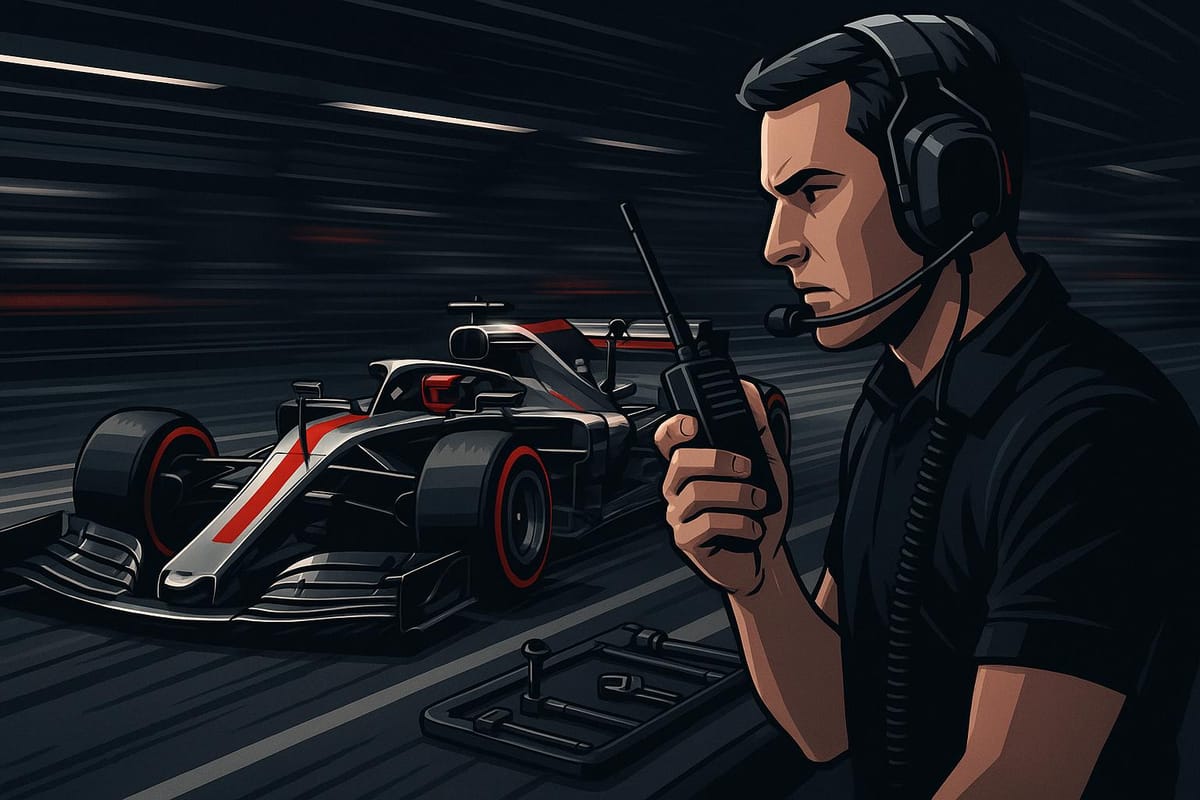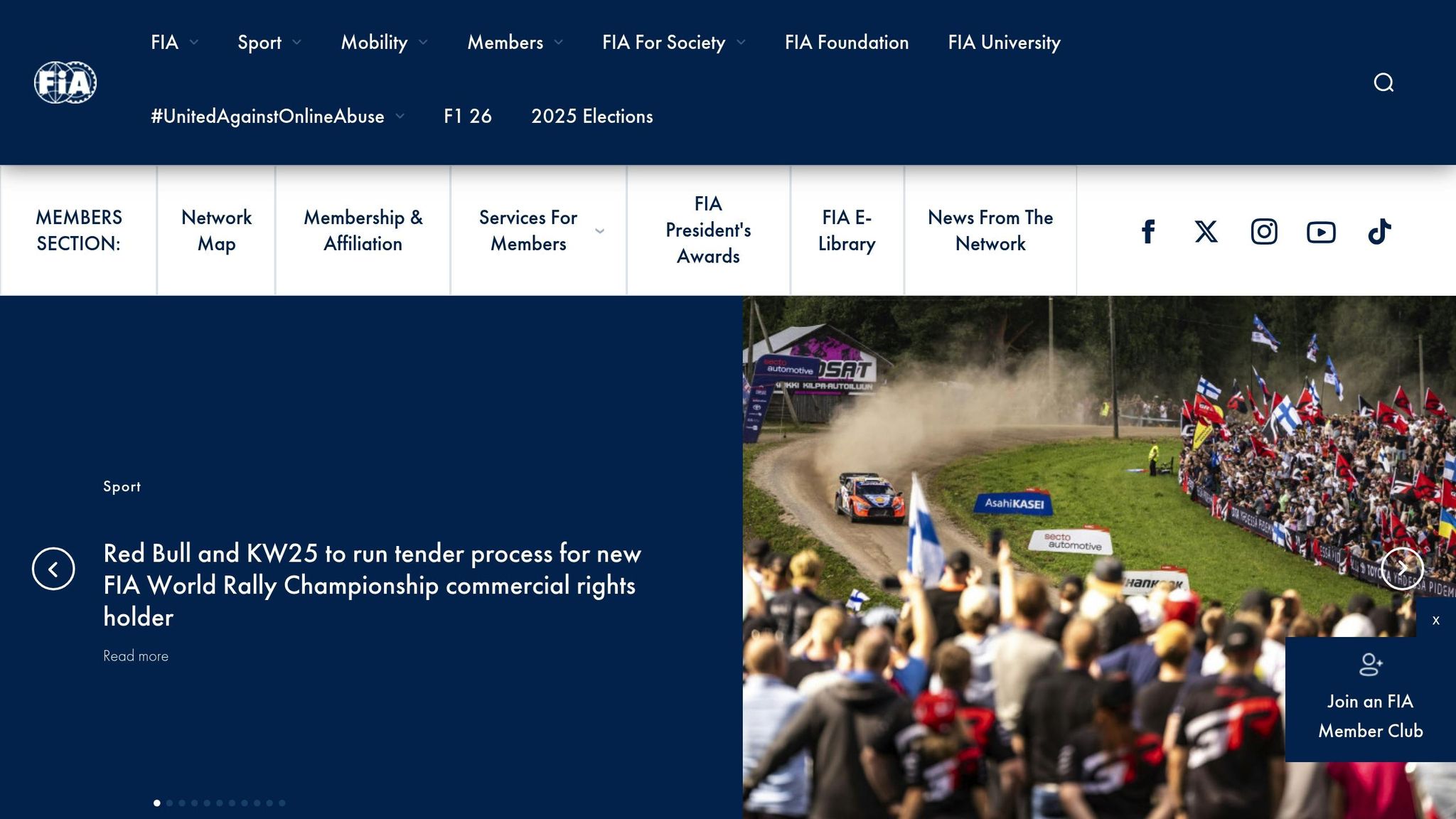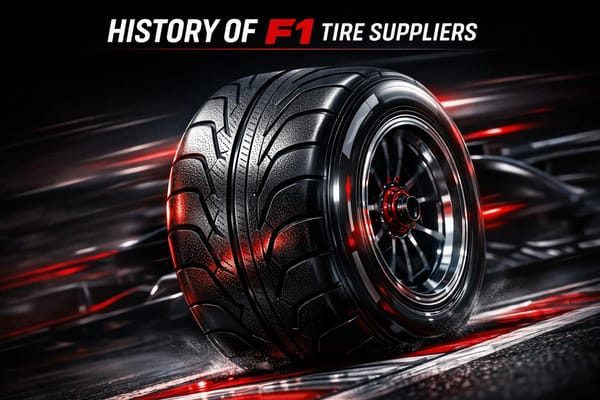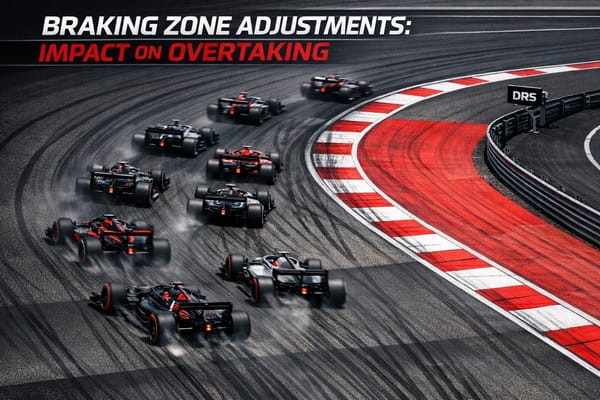Solving Radio Rule Challenges in F1
Explore the challenges of F1 radio rules affecting team communication, strategy, and safety, along with potential solutions for improvement.

Formula One radio rules are a double-edged sword. They aim to ensure drivers operate independently, but they often hinder communication during critical moments. This creates challenges for teams in areas like strategy, safety, and performance.
Here’s a quick breakdown of the key issues and potential solutions:
-
Current Problems:
- Teams can’t provide real-time guidance on car settings or racing lines.
- Safety-critical messages are sometimes delayed due to rule restrictions.
- Drivers and engineers face increased stress due to limited communication.
-
Proposed Solutions:
- Time delays for broadcasted messages to filter sensitive content.
- Content-specific rules to allow unrestricted safety updates while limiting coaching.
- Alternative tools like cockpit displays or haptic feedback for non-verbal communication.
- Collaborative rule-making between the FIA, teams, and drivers for better regulations.
Each solution has pros and cons, but combining them could improve communication without compromising competition or safety. The goal is clear: refine F1’s radio rules to enhance race dynamics, protect drivers, and keep fans engaged.
FIA Threatens SHUTDOWN of F1 Team Radios

Problems Created by FIA Radio Rules
The FIA's radio rules, while intended to promote fairness, have unintentionally complicated team operations and raised concerns about driver safety. These restrictions create a maze of limitations that can hinder both performance and safety during critical moments in a race.
Limits on Team Operations
The restrictions on radio communication significantly impact how teams make strategic decisions and technical adjustments during races. Under current regulations, teams are prohibited from coaching drivers on racing lines, car settings, or optimal driving techniques while the engine is running.
This limitation becomes especially problematic during sudden weather changes or unexpected track conditions. Without the ability to provide real-time guidance, teams often miss strategic opportunities, leaving drivers to manage tire performance and adapt to shifting conditions on their own.
Technical adjustments are another area where these rules create challenges. If engineers notice anomalies in car performance that require immediate action, they are restricted in how much guidance they can provide to the driver. This lack of real-time support can force drivers to operate in less-than-ideal settings, potentially costing valuable race positions or even jeopardizing the car’s reliability.
But the operational hurdles don’t stop at performance - they also extend to safety, where the stakes are even higher.
Safety Concerns
When it comes to safety, the radio rules can cause dangerous delays in communication. Teams are often limited in how quickly and clearly they can relay urgent information about mechanical issues, on-track hazards, or sudden changes in race conditions.
For instance, if a car develops a mechanical problem that the driver cannot detect from the cockpit, the team’s ability to guide the driver is heavily restricted. This can lead to situations where a preventable issue escalates into a serious failure, putting both the driver and others on the track at risk.
Even in scenarios where safety communications are allowed, the rules can create confusion. Teams must carefully determine what qualifies as permissible safety information versus prohibited coaching. This gray area can lead to hesitation, delaying critical messages about track hazards or safety car procedures. In a sport where split-second decisions are crucial, these delays can have severe consequences.
The ripple effects of these restrictions don’t just stay on the track - they also influence the dynamics within teams and the overall performance of drivers.
Effects on Team Dynamics and Driver Performance
The communication restrictions increase stress for both drivers and engineers, eroding confidence and leading to mistakes during high-pressure situations.
Drivers, especially those newer to the sport, often rely on real-time guidance from their teams to build their skills and make informed decisions. Knowing that this support is limited can undermine their confidence, making it harder to perform at their best during critical moments.
Meanwhile, engineers face their own set of challenges. Watching a race unfold while being unable to share insights or solutions can be deeply frustrating, leading to lower morale and heightened tension within the team. To compensate, teams must dedicate significantly more time to pre-race planning, knowing they’ll have limited ability to adapt strategies once the race begins.
Ultimately, these restrictions shift the focus of Formula One races. Instead of showcasing real-time strategic excellence and teamwork, the emphasis leans more heavily on pre-race preparation and individual driver skill. This shift alters the collaborative essence of the sport, potentially diminishing the technical and strategic elements that have long been central to Formula One’s identity.
How Teams Work Around Radio Rules
F1 teams have found creative ways to navigate radio restrictions, combining pre-race strategies with cutting-edge technology to keep communication flowing.
Technology Solutions
Today's F1 teams use highly advanced digital radio systems to stay within FIA regulations while ensuring effective communication. These systems often rely on TETRA networks and encryption, providing secure and private pit-to-cockpit transmissions. Over the years, teams have shifted from basic analog radios to these sophisticated digital setups, making technology a vital tool in managing radio limitations.
With features like encrypted channels and noise-canceling headsets, these modern systems allow teams to communicate clearly during high-pressure moments without violating FIA rules. This balance of compliance and efficiency ensures teams can make the most of their allowed communications while maintaining a competitive edge.
Solutions to Fix Radio Rule Problems
Radio restrictions can create obstacles for crucial communication during races, impacting both safety and competitive strategies. To address these challenges, several solutions have been proposed, including time delays for transmissions, content-specific rules, alternative communication methods, and collaborative rule-making efforts.
Time Delay Systems
One idea is to implement a brief broadcast delay for team radio messages. This delay, similar to what's used in live television broadcasts, would allow race officials to monitor and filter communications without significantly affecting the flow of real-time information. Digital broadcast delay technologies already exist and could be adapted with minimal changes, ensuring that critical updates reach drivers without unnecessary hesitation.
Different Rules for Specific Messages
Another approach suggests categorizing messages by their content. For example, safety-critical updates - like mechanical warnings, sudden weather changes, or track hazards - could remain unrestricted to prioritize driver safety. On the other hand, strategic coaching or performance-related advice could continue to face stricter regulations during races. This tiered system would require clear guidelines to distinguish between essential safety updates and other types of communication, ensuring drivers receive vital information without compromising the competitive nature of the sport.
Exploring Alternative Communication Methods
Teams are also looking into other ways to communicate that don’t rely entirely on radio transmissions. Options like integrated digital displays in the cockpit, enhanced coded pit boards, or even experimental tools like haptic feedback systems could provide drivers with instant access to key information.
Additionally, more detailed pre-race briefings could establish clear protocols for various scenarios, reducing the reliance on extensive real-time radio communication during the race itself.
Collaborative Rule-Making
Regular discussions among race engineers, drivers, and technical delegates could help address communication challenges and refine the rules. These collaborative sessions would allow all parties to share insights and develop practical solutions that balance safety, transparency, and fair competition. By working together, stakeholders can create a framework that benefits everyone involved.
These proposed solutions aim to strike the right balance - ensuring safety-critical messages are communicated promptly while maintaining the integrity of the rules designed to keep competition fair in Formula One.
Comparing the Solutions
After discussing the challenges and workarounds earlier, it's time to dive into a comparison of potential solutions. This comparison sheds light on the most practical approach for improving F1 radio communications.
Time delay systems are straightforward and easy to implement. This technology is already widely used in broadcasting, so adapting it for F1 would be relatively simple. However, it doesn't address which information should be restricted and could delay critical decisions during a race.
Content-specific messaging rules take a more targeted approach by separating safety-critical communications from strategic ones. While this prioritizes driver safety and preserves competitive fairness, it adds complexity. Engineers would need to categorize messages quickly, which could lead to hesitation in high-pressure moments.
Alternative communication methods introduce a fresh way of thinking by reducing reliance on traditional radio systems. Tools like digital displays or haptic feedback could revolutionize communication between teams and drivers. However, this approach demands significant technological investment and comes with a steep learning curve for both drivers and engineers.
Collaborative rule-making brings all stakeholders into the conversation. This inclusive approach could lead to better regulations that everyone supports. That said, it doesn't provide an immediate technical fix to the current communication challenges.
| Solution | Safety Impact | Implementation Complexity | Cost | Fan Transparency | Technical Feasibility |
|---|---|---|---|---|---|
| Time Delay Systems | Moderate | Low | Low | High | High |
| Content-Specific Rules | High | High | Low | Moderate | High |
| Alternative Communication | High | Very High | Very High | Low | Moderate |
| Collaborative Rule-Making | Moderate | Moderate | Low | High | High |
A well-rounded approach would combine these solutions: time delays for immediate oversight, content-specific rules for prioritizing safety, alternative technologies to reduce reliance on radio, and collaborative efforts to refine regulations.
Striking the right balance between quick fixes and long-term solutions is essential. While time delays can address pressing concerns, innovative methods like alternative communication systems could reshape how teams operate in the future. Together, these strategies offer a path forward for improving F1 communication.
Conclusion: Finding the Right Balance
F1 radio communication needs to strike a balance through smarter, data-driven rules. Recent seasons have shown that overly strict regulations can delay critical safety updates, while vague ones create confusion and inconsistent penalties. This lack of clarity can erode trust in the system. These challenges open the door for new approaches in both technology and rule-making.
One promising step has been the FIA's use of AI monitoring, which can assess not just the content but also the tone of communications for more precise enforcement. This allows for rules that differentiate between necessary safety updates and messages that might provide a competitive edge.
Collaboration between the FIA, teams, and drivers is just as important. Teams like Mercedes and Red Bull have already developed clever ways to share strategy updates while staying within the current rules. These examples underscore the need for clear, consistently applied guidelines that everyone can trust and work with.
Then there’s the fan experience. Team radio broadcasts have become a big part of what makes F1 exciting for viewers. Introducing time-delay systems for live broadcasts could help manage public perception without losing the raw, human moments that fans love.
As communication technology advances - think encryption and real-time data analysis - the rules need to keep pace. The aim isn’t to restrict team communication but to ensure it happens under fair and transparent conditions that prioritize safety and competition.
Ultimately, F1 thrives when its regulations evolve alongside the sport. Using data and expert input to refine the balance between driver autonomy, team strategy, and fan enjoyment will keep the sport dynamic and engaging.
FAQs
How do F1 radio rules affect driver safety and team strategies during races?
F1 Radio Rules: Balancing Safety and Strategy
The FIA's F1 radio rules play a key role in shaping both driver safety and team strategies. By restricting the type and frequency of communication between drivers and their teams, these rules encourage drivers to depend more on their instincts and decision-making skills during races. While this adds an element of challenge and excitement, it can also create difficulties, especially in high-stakes moments requiring split-second decisions.
From a safety perspective, limited radio communication can complicate the process of sharing crucial updates, like sudden weather changes or potential mechanical problems. On the strategy side, teams face the task of crafting their messages carefully to stay within the rules while still maximizing race performance. Whether it's deciding the perfect moment for a pit stop or managing tire usage, these restrictions force teams to find creative ways to stay competitive while adhering to the guidelines.
How can F1 teams improve communication with drivers while following radio rules?
To improve communication while adhering to the FIA's radio rules, teams can implement more structured protocols that focus solely on essential information. By doing so, they minimize unnecessary distractions for drivers and promote greater independence in decision-making during races.
Recent rule changes have further tightened restrictions on specific types of messages, such as detailed sector times or fuel levels. These adjustments are designed to encourage a fairer, more strategic racing environment while upholding the sport's competitive edge and safety standards.
How could technologies like cockpit displays or haptic feedback improve F1 team communication during races?
How Technology Could Transform F1 Communication
New advancements like cockpit displays and haptic feedback are set to change the way F1 teams and drivers communicate during races. These tools deliver real-time visual and physical cues, cutting down the need for frequent radio messages and helping drivers stay fully focused on the race.
Take haptic feedback, for instance. This technology lets drivers feel vibrations or pressure changes that mimic tire grip, engine performance, or even track conditions. By providing this critical information directly through the cockpit, drivers can react faster and make better decisions on the fly. It’s also a clever way for teams to work within FIA’s strict radio communication rules while maintaining peak efficiency. These innovations could lead to more seamless and independent race strategies in the future.




